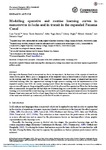Mostrar o rexistro simple do ítem
Modelling Operative and Routine Learning Curves in Manoeuvres in Locks and in Transit in the Expanded Panama Canal
| dc.contributor.author | Carral Couce, Luis | |
| dc.contributor.author | Tarrío-Saavedra, Javier | |
| dc.contributor.author | Vega Sáenz, Adán | |
| dc.contributor.author | Bogle, Johnny | |
| dc.contributor.author | Alemán, Gabriel | |
| dc.contributor.author | Naya, Salvador | |
| dc.date.accessioned | 2021-06-08T15:15:59Z | |
| dc.date.available | 2021-06-08T15:15:59Z | |
| dc.date.issued | 2021-05 | |
| dc.identifier.citation | Carral, L., Tarrío-Saavedra, J., Sáenz, A., Bogle, J., Alemán, G., & Naya, S. (2021). Modelling operative and routine learning curves in manoeuvres in locks and in transit in the expanded Panama Canal. Journal of Navigation, 74(3), 633-655. doi:10.1017/S0373463320000727 | |
| dc.identifier.issn | 1469-7785 | |
| dc.identifier.uri | http://hdl.handle.net/2183/28063 | |
| dc.description | Financiado para publicación en acceso aberto: Universidade da Coruña/CISUG | es_ES |
| dc.description.abstract | [Abstract] Piloting in the Panama Canal is exceptional as, due to its importance, the functions of the captains of vessels are taken over by pilots. Hence, prior to inauguration of the expanded canal, a limited number of pilots experienced on the existing canal were certified for the transit of Neopanamax vessels by means of planned and innovative individual learning. After this organisational training through operative training, with the implementation of the expanded canal in June 2016, the routine training started. Hence the learning curve in the performance of these manoeuvres will represent the growing skill acquired by both the pilots and the organisation. Given that the learning effect is measurable, this paper has the dual objective of determining two curve models: the organisation operative learning curve model and the routine learning curve model for pilots performing transit manoeuvres in the expanded Panama Canal waterways and the Cocolí and Agua Clara locks. Manoeuvre times in locks and transit in the whole of the canal were followed up continuously in the first 42 months of operation. | es_ES |
| dc.description.sponsorship | The research of Salvador Naya and Javier Tarrío has been supported by MINECO grant MTM2017-82724-R, and by the Xunta de Galicia (Grupos de Referencia Competitiva ED431C-2020-14 and Centro de Investigación del Sistema universitario de Galicia ED431G 2019/01), all of them through the ERDF. This work has been funded in part by Project 1-FACINA of the International Maritime University of Panama (UMIP). | |
| dc.description.sponsorship | Xunta de Galicia; ED431C-2020-14 | |
| dc.description.sponsorship | Xunta de Galicia; ED431G 2019/01 | |
| dc.description.sponsorship | Universidad Marítima Internacional de Panamá; Project 1-FACINA | |
| dc.language.iso | eng | es_ES |
| dc.publisher | Cambridge University Press | es_ES |
| dc.relation | info:eu-repo/grantAgreement/AEI/Plan Estatal de Investigación Científica y Técnica y de Innovación 2017-2020/MTM2017-82724-R/ES/INFERENCIA ESTADISTICA FLEXIBLE PARA DATOS COMPLEJOS DE GRAN VOLUMEN Y DE ALTA DIMENSION | |
| dc.relation | info:eu-repo/grantAgreement/Xunta de Galicia/2020/ED431C-2020-14/ES-GA | |
| dc.relation | info:eu-repo/grantAgreement/Xunta de Galicia/2019/ED431G 2019%01/ES-GA | |
| dc.relation.uri | https://doi.org/10.1017/S0373463320000727 | es_ES |
| dc.rights | Atribución 4.0 Internacional | es_ES |
| dc.rights.uri | http://creativecommons.org/licenses/by/4.0/ | * |
| dc.subject | Canal de Panamá - Navegación | es_ES |
| dc.subject | Buques - Maniobras | es_ES |
| dc.subject | Expanded Panama Canal | |
| dc.subject | Learning effect | |
| dc.subject | Learning curve | |
| dc.subject | Lockage time | |
| dc.subject | Transit time | |
| dc.subject | Non-linear regression | |
| dc.subject | Generalised additive models | |
| dc.title | Modelling Operative and Routine Learning Curves in Manoeuvres in Locks and in Transit in the Expanded Panama Canal | es_ES |
| dc.type | info:eu-repo/semantics/article | es_ES |
| dc.rights.access | info:eu-repo/semantics/openAccess | es_ES |
| UDC.journalTitle | The Journal of Navigation | es_ES |
| UDC.volume | 74 | es_ES |
| UDC.issue | 3 | es_ES |
| UDC.startPage | 633 | es_ES |
| UDC.endPage | 655 | es_ES |
| dc.identifier.doi | 10.1017/S0373463320000727 |
Ficheiros no ítem
Este ítem aparece na(s) seguinte(s) colección(s)
-
CIT-GEM - Artigos [21]
-
GI-MODES - Artigos [132]






